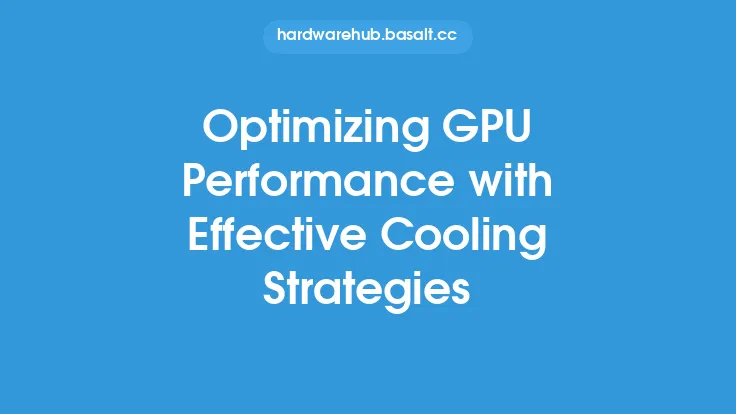When it comes to keeping your graphics processing unit (GPU) at a safe temperature, there are two primary methods of cooling: air cooling and liquid cooling. Both methods have their own set of advantages and disadvantages, and the choice between them depends on various factors such as the type of GPU, the system's configuration, and personal preference. In this article, we will delve into the details of air cooling and liquid cooling, exploring their principles, components, and effectiveness in keeping your GPU at optimal temperatures.
Introduction to Air Cooling
Air cooling is the most common method of cooling GPUs, and it involves using a heatsink and fan to dissipate heat from the GPU. The heatsink is typically made of a thermally conductive material such as copper or aluminum, and it is designed to maximize the surface area in contact with the GPU. The fan, on the other hand, is responsible for circulating air through the heatsink, carrying heat away from the GPU. Air cooling is a simple and cost-effective method, and it is often sufficient for mid-range and low-end GPUs. However, it can be limited by the amount of heat it can dissipate, and it may not be effective for high-end GPUs or overclocked systems.
Introduction to Liquid Cooling
Liquid cooling, also known as water cooling, is a more advanced method of cooling that involves circulating a liquid coolant through a closed-loop system. The liquid coolant is designed to have a high thermal conductivity, allowing it to absorb heat from the GPU and transfer it to a radiator, where it is dissipated. Liquid cooling is more effective than air cooling, especially for high-end GPUs or overclocked systems, as it can dissipate more heat and maintain a lower temperature. However, it is also more complex and expensive, requiring a pump, reservoir, radiator, and tubing, in addition to the coolant itself.
Comparison of Air Cooling and Liquid Cooling
When comparing air cooling and liquid cooling, there are several factors to consider. Air cooling is generally less expensive and easier to install, as it requires minimal modification to the system. However, it can be noisier and less effective, especially at high temperatures. Liquid cooling, on the other hand, is more expensive and complex, requiring a significant investment in hardware and installation. However, it is also more effective and quieter, as the liquid coolant can absorb and dissipate heat more efficiently. Additionally, liquid cooling can be more aesthetically pleasing, as the tubing and radiator can be customized to fit the system's design.
Technical Considerations
From a technical perspective, both air cooling and liquid cooling have their own set of considerations. Air cooling relies on the principles of convection and conduction, where the fan circulates air through the heatsink, and the heatsink absorbs heat from the GPU through direct contact. The effectiveness of air cooling depends on the design of the heatsink, the speed and airflow of the fan, and the thermal interface material (TIM) used to connect the heatsink to the GPU. Liquid cooling, on the other hand, relies on the principles of convection and heat transfer, where the liquid coolant absorbs heat from the GPU and transfers it to the radiator, where it is dissipated. The effectiveness of liquid cooling depends on the design of the radiator, the flow rate and pressure of the coolant, and the thermal interface material (TIM) used to connect the coolant to the GPU.
Components and Materials
The components and materials used in air cooling and liquid cooling also play a crucial role in their effectiveness. Air cooling typically uses a heatsink made of copper or aluminum, with a fan that is designed to provide a high airflow and static pressure. The thermal interface material (TIM) used to connect the heatsink to the GPU is also critical, as it must provide a high thermal conductivity and a low thermal resistance. Liquid cooling, on the other hand, uses a liquid coolant that is designed to have a high thermal conductivity and a low viscosity, allowing it to flow easily through the system. The radiator is typically made of a thermally conductive material such as copper or aluminum, and it is designed to provide a high surface area for heat dissipation. The tubing and fittings used in liquid cooling must also be designed to withstand the pressure and flow rate of the coolant, while minimizing leakage and corrosion.
Conclusion
In conclusion, both air cooling and liquid cooling are effective methods of cooling GPUs, each with their own set of advantages and disadvantages. Air cooling is a simple and cost-effective method that is suitable for mid-range and low-end GPUs, while liquid cooling is a more advanced method that is suitable for high-end GPUs or overclocked systems. The choice between air cooling and liquid cooling depends on various factors such as the type of GPU, the system's configuration, and personal preference. By understanding the principles, components, and technical considerations of both methods, users can make an informed decision and choose the best cooling solution for their system.





